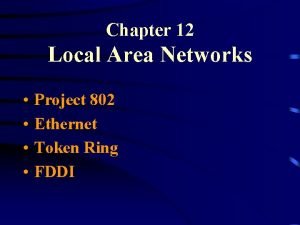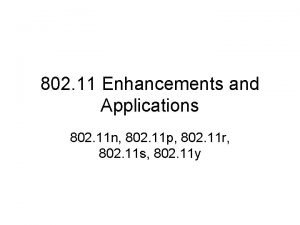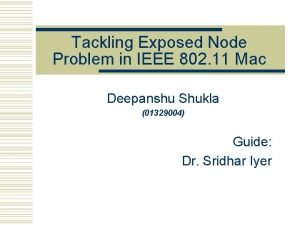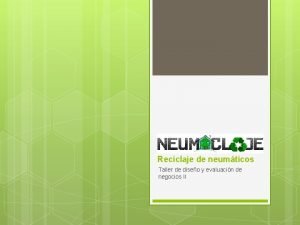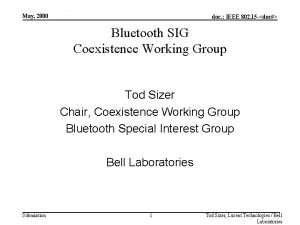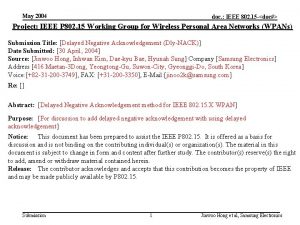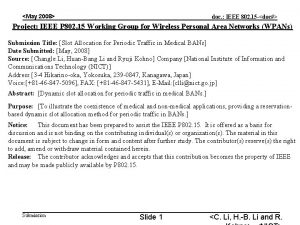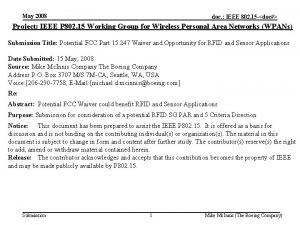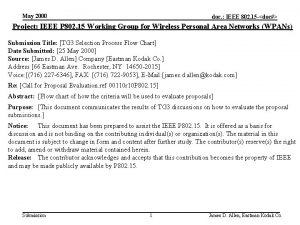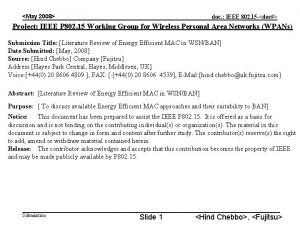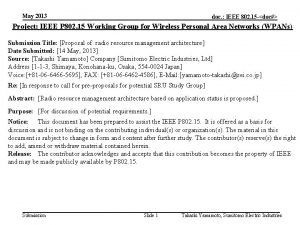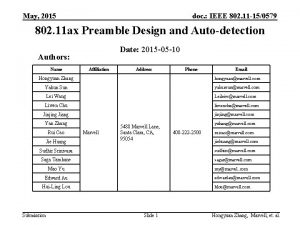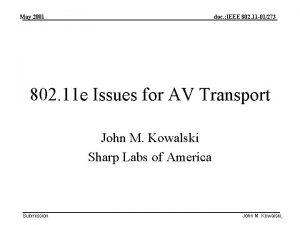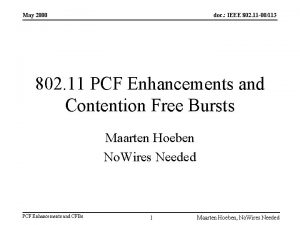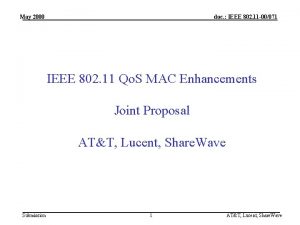May 2016 doc IEEE 802 11 160673 r














![May 2016 doc. : IEEE 802. 11 -16/0673 r 0 References [1] Draft P May 2016 doc. : IEEE 802. 11 -16/0673 r 0 References [1] Draft P](https://slidetodoc.com/presentation_image_h/3735fd077ff1047c174d1840049c125b/image-15.jpg)
- Slides: 15

May 2016 doc. : IEEE 802. 11 -16/0673 r 0 Multi-User EDCA Date: 2016 -05 -15 Authors: Submission Slide 1 Jinsoo Ahn, Yonsei University

May 2016 doc. : IEEE 802. 11 -16/0673 r 0 Introduction • MU DL is defined for MU-MIMO procedure in 11 ac[1] – Sharing a TXOP is a channel access scheme for MU-MIMO – Channel Access follows the rules for the Access Category of Primary Access Category – Transmission success is judged by Primary transmission only • 802. 11 ax MU UL channel access has not been defined yet • Many comments are related to Access Category and channel access of UL MU transmission[2] – CID 158, 799, 809, 814, 815, 816, 1646, 2173, 2271, 2638, 2644, 2656 • In this contribution, virtual queue for UL MU transmission to remove the ambiguities regarding UL MU is discussed. Submission Slide 2 Jinsoo Ahn, Yonsei University

May 2016 doc. : IEEE 802. 11 -16/0673 r 0 Review – DL MU-MIMO transmission[1] • • TXOP Initiator = TX Data Multiple AC could exist on DL Data Choose Primary AC by virtual contention DL OFDMA may reuse this scheme[3] Submission Slide 3 Jinsoo Ahn, Yonsei University

May 2016 doc. : IEEE 802. 11 -16/0673 r 0 Channel Access for Trigger Frame Ambiguity 1 When or How often Trigger Frames should be transmitted? AP AIFS Trigger Frame STA 1 UL PPDU M-BA STA 2 UL PPDU STA 3 UL PPDU STAs Ambiguity 2 Which EDCA parameters should Trigger Frame follow ? • MU UL begins with Trigger Frame transmitted by AP • Need to define a procedure whether to transmit DL data or to transmit Trigger Frame • Hard to know which EDCA parameters are appropriate for UL transmission Submission Slide 4 Jinsoo Ahn, Yonsei University

May 2016 doc. : IEEE 802. 11 -16/0673 r 0 Channel Access for Trigger Frame • Buffer Status Report (BSR) Procedure was adopted for 802. 11 ax MU UL and it should be used for AP to determine UL transmission scheduling – DL transmission or UL transmission – UL Trigger Frame transmission timing • Although Buffer Status Report Procedure is defined, Access Category or TID of UL data can not be regulated for MU UL transmission – Trigger Frame can not restrict transmission of any AC or TID of STAs • Therefore, applying legacy access category scheme including ‘sharing a TXOP scheme’ for Trigger Frame Channel Access is not feasible Submission Slide 5 Jinsoo Ahn, Yonsei University

May 2016 doc. : IEEE 802. 11 -16/0673 r 0 UL MU access category for Trigger Frame • UL MU Access Category and UL MU virtual queue can clarify the two ambiguities of UL MU channel Access – When or how often Trigger Frames should be transmitted ? – Which EDCA parameters should Trigger Frame follow ? • Queue size of AC_MU is determined with cumulated Buffer Status Report information and STAs SU transmission status Submission Slide 6 Jinsoo Ahn, Yonsei University

May 2016 doc. : IEEE 802. 11 -16/0673 r 0 UL MU access category for Trigger Frame • For internal contention, UL MU virtual contention parameters controlled by virtual queue size – Large virtual queue size should provide a high probability of channel access small Backoff (BO) value • If AC_MU wins the internal contention, trigger frame follows the channel access parameters of AC_MU Submission Slide 7 Jinsoo Ahn, Yonsei University

May 2016 doc. : IEEE 802. 11 -16/0673 r 0 UL MU access category for Trigger Frame • Backoff (BO) values should be controlled depending on the AC_MU queue size – BO values should be controlled with Contention Window (CW) size – Unlike the conventional BO, minimum(Min) BO should be regulated to solicit large number of STAs. Submission Slide 8 Jinsoo Ahn, Yonsei University

May 2016 doc. : IEEE 802. 11 -16/0673 r 0 Example of UL MU Contention Control Category Queue Length(Q) Min BO CW(Max BO) 1 (Hold BO) Q<Th_1 1024 (Hold) 2 Th_1≤Q<Th_2 8 31 3 Th_2≤Q<Th_3 0 31 4 ⁞ ⁞ ⁞ N+1 (N≥ 1) Th_n≤Q 0 0 • AC_MU gets virtual back-off values in the range of [Min BO, CW] instead of [0, CW] • If the queue length of AC_MU(UL) is smaller than certain threshold value, trigger frame cannot get a transmission opportunity due to its large minimum back off number • Either fixed CW or variable CW can be used – N>1 : variable CW – N=1 : fixed CW with UL MU threshold Submission Slide 9 Jinsoo Ahn, Yonsei University

May 2016 doc. : IEEE 802. 11 -16/0673 r 0 Channel Access for Trigger Frame BO=[Min. BO, CW] AP AIFS(AC_MU) Trigger Frame STA 1 UL PPDU M-BA STA 2 UL PPDU STA 3 UL PPDU STAs TXOP(AC_MU) • When AC_MU wins the virtual contention, Trigger frame is transmitted with Trigger frame access category (AC_MU) EDCA parameters • EDCA parameters for Trigger frame access category (AC_MU) needs to be defined – Not only fixed value, but also variable value which is based on queue length could be considered (Legacy ACs could be reused for AC_MU, e. g. , AC_VI) Submission Slide 10 Jinsoo Ahn, Yonsei University

May 2016 doc. : IEEE 802. 11 -16/0673 r 0 Revisit: DL MU channel access procedure • We could have two options of DL MU – Opt. 1 : Using sharing a TXOP method for both DL-MU MIMO and DL -MU-OFDMA – Opt. 2 : Using virtual DL_MU queue similar to virtual UL_MU queue • Opt. 1 is simple but it has some regulations – Since the failure of Primary transmission is regarded as the transmission failure, an inefficient procedure should be taken, i. e. , CW should be doubled – Multi-TID cannot be used for Primary transmission • Opt. 2 requires new procedure but it could be more flexible – Transmission success can be more properly defined (e. g. Only one response of DL MU transmission can be considered as a success) – Multi-TID A-MPDU could be utilized for DL MU as well Submission Slide 11 Jinsoo Ahn, Yonsei University

May 2016 doc. : IEEE 802. 11 -16/0673 r 0 Further Discussion on MU Channel Access • We need more discussion whether “sharing a TXOP” is efficient and only option for DL MU channel access. • Specific parameters for contention need to be defined. – Min BO, Max BO(=CW), TXOP, AIFSN – Whether parameters are variable or fixed • If other Trigger variant frames need to be transmitted with contention based channel access, Trigger variant frames’ channel access methods need to be defined. – MU-RTS may follow EDCA of the following channel access procedure of MU data transmission. – UL MU for management frames including BSR procedure may use different mechanism and UL MU parameters. Submission Slide 12 Jinsoo Ahn, Yonsei University

May 2016 doc. : IEEE 802. 11 -16/0673 r 0 Conclusion • MU UL virtual queue based on BSR information could be a solution for 11 ax EDCA • Variable virtual contention parameters for AC_MU could control when and how often Trigger frames are transmitted • Although BSR procedure is considered for UL MU transmission, actual UL PPDU could be a Multi-TID AMPDU and its Access Category is hard to known to AP – AP cannot determine which access category shall be adopted for channel access parameters – Regardless of UL PPDU contents, Trigger frame always need to be transmitted following AC_MU Submission Slide 13 Jinsoo Ahn, Yonsei University

May 2016 doc. : IEEE 802. 11 -16/0673 r 0 Straw. Poll 1 • Do you agree to add to the TG Specification Frame work document? – x. y. z. Spec shall define a virtual queue for UL MU contention based channel access procedure and its EDCA parameters (TBD) for trigger frame channel access • Y • N • A Submission Slide 14 Jinsoo Ahn, Yonsei University
![May 2016 doc IEEE 802 11 160673 r 0 References 1 Draft P May 2016 doc. : IEEE 802. 11 -16/0673 r 0 References [1] Draft P](https://slidetodoc.com/presentation_image_h/3735fd077ff1047c174d1840049c125b/image-15.jpg)
May 2016 doc. : IEEE 802. 11 -16/0673 r 0 References [1] Draft P 802. 11 REVmc_D 5. 0 [2] 11 -16/0535 r 03 “Comments on TGax D 0. 1” [3] 11 -15/0132 r 16 “Spec Framework” Submission Slide 15 Jinsoo Ahn, Yonsei University












